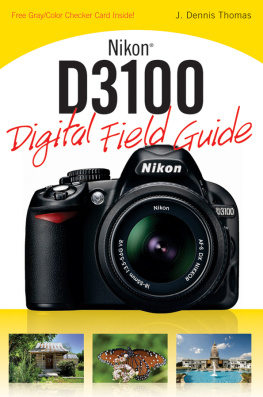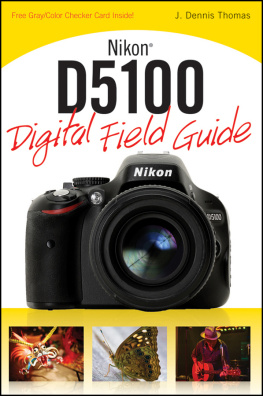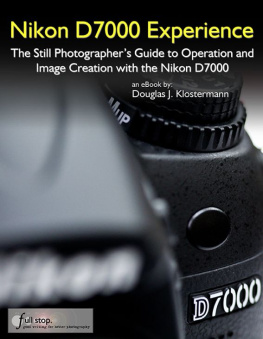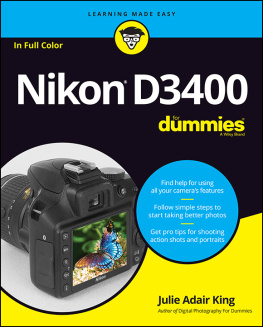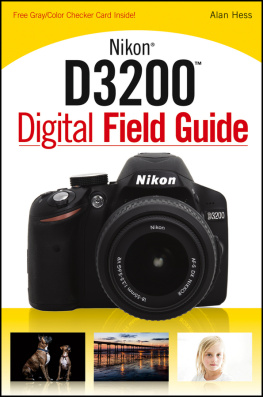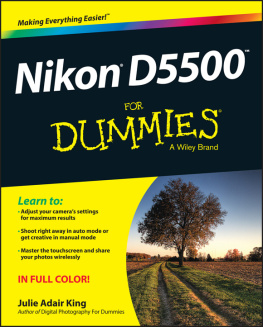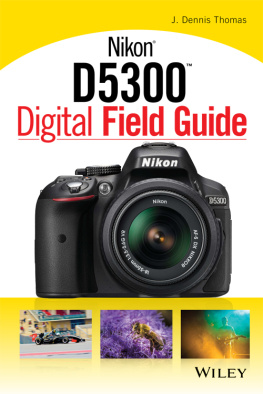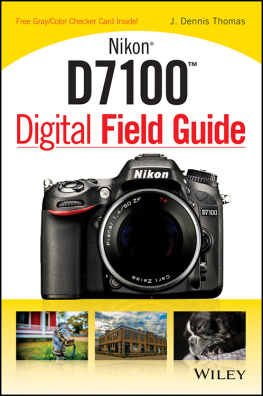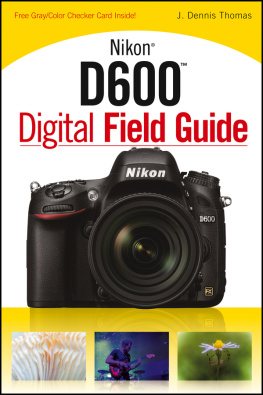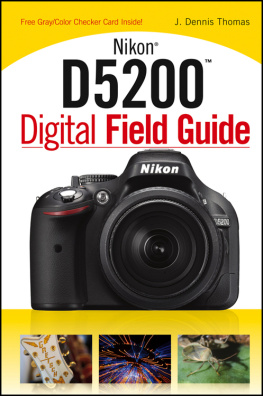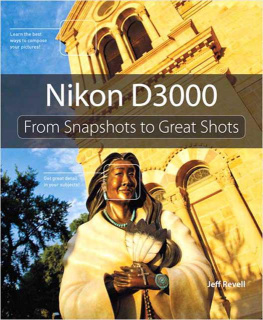Nikon D3100 Digital Field Guide
J. Dennis Thomas
Nikon D3100 Digital Field Guide
Published by
Wiley Publishing, Inc.
111 River Street
Hoboken, NJ 07030-5774
www.wiley.com
Copyright 2011 by Wiley Publishing, Inc., Indianapolis, Indiana
Published simultaneously in Canada
No part of this publication may be reproduced, stored in a retrieval system or transmitted in any form or by any means, electronic, mechanical, photocopying, recording, scanning or otherwise, except as permitted under Sections 107 or 108 of the 1976 United States Copyright Act, without either the prior written permission of the Publisher, or authorization through payment of the appropriate per-copy fee to the Copyright Clearance Center, 222 Rosewood Drive, Danvers, MA 01923, (978) 750-8400, fax (978) 646-8600. Requests to the Publisher for permission should be addressed to the Permissions Department, John Wiley & Sons, Inc., 111 River Street, Hoboken, NJ 07030, (201) 748-6011, fax (201) 748-6008, or online at http://www.wiley.com/go/permissions.
Trademarks: Wiley and the Wiley Publishing logo are trademarks or registered trademarks of John Wiley & Sons, Inc. and/or its affiliates. Nikon is a trademark of Nikon, Inc. All other trademarks are the property of their respective owners. Wiley Publishing, Inc. is not associated with any product or vendor mentioned in this book.
Limit of Liability/Disclaimer of Warranty: The publisher and the author make no representations or warranties with respect to the accuracy or completeness of the contents of this work and specifically disclaim all warranties, including without limitation warranties of fitness for a particular purpose. No warranty may be created or extended by sales or promotional materials. The advice and strategies contained herein may not be suitable for every situation. This work is sold with the understanding that the publisher is not engaged in rendering legal, accounting, or other professional services. If professional assistance is required, the services of a competent professional person should be sought. Neither the publisher nor the author shall be liable for damages arising herefrom. The fact that an organization or Website is referred to in this work as a citation and/or a potential source of further information does not mean that the author or the publisher endorses the information the organization or Website may provide or recommendations it may make. Further, readers should be aware that Internet Websites listed in this work may have changed or disappeared between when this work was written and when it is read.
For general information on our other products and services, please contact our Customer Care Department within the U.S. at 877-762-2974, outside the U.S. at 317-572-3993, or fax 317-572-4002.
For technical support, please visit www.wiley.com/techsupport.
Wiley also publishes its books in a variety of electronic formats. Some content that appears in print may not be available in electronic books.
Library of Congress Control Number: 2010929411
ISBN: 978-0-470-64865-0
Manufactured in the United States of America
10 9 8 7 6 5 4 3 2 1

About the Author
J. Dennis Thomas is a freelance photographer and author based out of Austin, Texas. He has nearly 25 years of experience behind the lenses of Nikon cameras. His work has been published in regional, national, and international publications including Rolling Stone, SPIN, Country Music Weekly, and SXSW World magazines. He has written ten highly successful Digital Field Guides for Wiley Publishing with more in the works.
Acknowledgments
Thanks to everyone at Wiley, especially Courtney and Carol, for all their help.
Credits
Acquisitions Editor
Courtney Allen
Project Editor
Cricket Krengel
Technical Editor
Alan Hess
Editorial Director
Robyn Siesky
Editorial Manager
Rosemarie Graham
Business Manager
Amy Knies
Senior Marketing Manager
Sandy Smith
Vice President and Executive Group Publisher
Richard Swadley
Vice President and Executive Publisher
Barry Pruett
Project Coordinator
Kristie Rees
Graphics and Production Specialists
Samantha Cherolis
Jennifer Henry
Andrea Hornberger
Nikki Gately
Proofreading and Indexing
Melissa D. Buddendeck
Valerie Haynes Perry
Introduction
Welcome to the Nikon D3100 Digital Field Guide. This book is a handy reference for you to get started learning about all of the features and functions of your Nikon D3100 dSLR camera.
This Digital Field Guide isnt meant to replace the users manual but to be an adjunct to it, explaining things more simply and in more detail than in the manual. The guide is aimed at D3100 owners who are just beginning in the world of digital SLRs up to advanced users with more hands-on knowledge of photography.
The Nikon D3100 Digital Field Guide covers not only the specifics of the D3100 but also many other facets of digital photography, from the basics of exposure to lighting and composition. Theres also a chapter to help you get started with Nikons Creative Lighting System and all of the possibilities that Nikons Speedlights offer.
About This Book
The first few chapters cover the basics of the camera: the buttons and switches, the menu options, and the different settings. These are all described in detail with some tips on how to effectively use them.
Other chapters include information on lenses, how they work, and what applications specific lenses are best for. Theres a primer on working with different lighting types as well as a chapter that teaches you how to take on different photographic tasks.
To put it simply, theres a lot of information in this book. Theres a good bit of information for everyone, from the new photographer to the advanced hobbyist.
About the D3100
The D3100 is Nikons newest and possibly its most innovative camera released since the D90. Nikon has finally included full 1080p HD video in a dSLR and, in addition, they have added a full time autofocus feature that no other camera manufacturer offers. Nikon took the small size of the D3000 camera body and built on it. The D3100 has many useful features to allow the beginning photographer to grow with the camera while also appealing to those more advanced photographers who have become accustomed to cameras that have buttons to adjust the setting rather than doing everything through the menu mode. If you are stepping up from the D3000 or similar camera, such as a D40, you will surely appreciate these added buttons. And, you will definitely notice that changing the settings is much quicker with a simple flick of a switch or press of a button.
One big step up from the D3000 is the addition of a 14.2 megapixel CMOS sensor with the brand new EXPEED 2 image processor. This is the highest resolution camera Nikon offers with the exception of the top-of-the-line D3X. The EXPEED 2 image processor promises to deliver low noise images even at higher ISO settings.
The D3100 has also inherited the Multi-CAM 1000 autofocus (AF) module that was introduced with Nikons semiprofessional D200. This is a very fast and accurate AF module that allows precise control of focus points. The D3100 also has 3D-tracking focus, which makes it a snap for shooting pictures of moving subjects without worrying about focus.

